
This is an edition of The Atlantic Daily, a newsletter that guides you through the biggest stories of the day, helps you discover new ideas, and recommends the best in culture. Sign up for it here.
Yesterday afternoon, Hurricane Ian made landfall in Florida as a Category 4 storm, unleashing strong winds, a severe storm surge, and historic inland flooding across the state. President Joe Biden announced early reports of a “substantial loss of life.”
But first, here are three new stories from The Atlantic.
- How the anti-war camp went intellectually bankrupt
- Why sports should be separated by sex
- Putin didn’t think he would fool anyone.
Uncertain Path
A little more than 24 hours after Hurricane Ian made landfall in southwest Florida, much remains unknown. But the picture is coming together, and it is grim.
“This could be the deadliest storm in Florida history,” Biden told reporters in a press conference this afternoon at FEMA headquarters in Washington, D.C. “The numbers are still unclear, but we’re hearing early reports of what may be substantial loss of life.”
What’s made Ian exceptional isn’t just its sheer force, but its general unpredictability. Monday storm predictions had Ian landing directly in the Tampa Bay area; instead it hit some 75 miles south. But it’s not just about where the storm is moving, but how it’s moving. As Ian shifted course, it intensified dramatically—and fast.
Then there’s what happens beyond the storm’s direct point of impact. Hurricanes that make landfall technically travel along coasts, but they can trigger severe storm surges well inland. That’s what’s happened with Ian—and what was so difficult to anticipate far enough in advance to evacuate as many residents as possible. Messaging around the storm’s directional shifts may have also deterred some residents from evacuating, even as it became clear that they would likely get caught in Ian’s path. As my colleague Robinson Meyer writes, when meteorologists confidently predict that a storm will rapidly intensify, they don’t always effectively communicate its risks to the public. In densely populated regions like Florida’s Gulf Coast, this convergence of variables can be particularly devastating.
As of this morning, more than 2.6 million Florida power customers were without power across the state. The storm also severely damaged the Sanibel Causeway and Pine Island Bridge, severing the land connection to two barrier islands. This morning, Florida Governor Ron DeSantis offered a grave assessment of the storm’s damage. “You’re looking at a storm that’s changed the character of a significant part of our state, and this is going to require … years of effort, to be able to rebuild, to come back,” he said. The sheriff of Lee County—which includes the popular vacation city of Fort Myers—reports that emergency personnel in the area have received thousands of 911 calls and are unable to keep up with the volume of people in need.
Local officials are surveying the damage to housing and infrastructure, while search-and-rescue efforts are under way. President Biden has approved major disaster relief for Florida residents in nine counties, including grants for temporary housing, home repairs, and low-cost loans to cover uninsured property losses.
Following its downgrade to a tropical storm this morning, Ian regained momentum and, as of this writing, has been reclassified as a Category 1 hurricane. Hurricane-force winds are anticipated across the South Carolina coast beginning early tomorrow and hurricane conditions remain likely for northeastern Florida and Georgia. As the storm continues along its northward coastal path, a “danger of a life-threatening storm surge” warning is in effect through tomorrow along the coasts of northeast Florida, Georgia, and South Carolina. Florida, Georgia, South Carolina, North Carolina, and Virginia remain in states of emergency.
Related:
- Early photos of Hurricane Ian’s landfall in Florida
- Honestly? The link between climate change and hurricanes is complicated.
Today’s News
- In remarks broadcast on state television, Vladimir Putin said that the Russian government had made “mistakes” in carrying out his recent draft, likely a response to the anger and public protests that have sprung up across Russia.
- Six people were injured yesterday in a shooting on a school campus in Oakland, California. All of the victims were over 18 years old.
- The Senate voted to approve a government-funding extension to prevent a shutdown at the end of this week.
Follow-up: In March, David French wrote about the “utterly unhinged” texts endorsing election conspiracy theories that Ginni Thomas exchanged with Mark Meadows in the weeks after the 2020 election. Today, Thomas, the wife of Supreme Court Justice Clarence Thomas, met with the House Select Committee investigating the January 6 attack.
Dispatches
- Work in Progress: Teachers and professors told Derek Thompson what Americans misunderstand about their profession.
- Up for Debate: Conor Friedersdorf proposes an unorthodox solution for the world’s migration woes.
Evening Read

Something Strange Happens When You Tear These Creatures Apart
When people die, our whole body dies with us. The heart stops pumping; the gut stops digesting; every cell that carries a person’s genetic blueprint eventually extinguishes, until their molecular signature is extinct. This is the curse of humans’—really, most animals’—multicellular makeup: The cells within our bodies are so specialized, so interdependent, that their fates are lashed together even in death.
Multicellularity does not have to manifest this way, however. Just a hop, skip, and a jump over from us on the tree of life are the choanoflagellates—little marine and freshwater creatures roughly the size of yeast. Choanoflagellates commonly appear as single cells with a long, whipping tail, a bulbous head, and a frilly collar, resembling, as my colleague Ed Yong has memorably described it, “a sperm wearing a skirt.” But under the right conditions, choanoflagellates can also bloom into many-celled bodies, joining individual cells together into single entities that, with some squinting and imagination, bear curious resemblances to the bodies of animals.
More From The Atlantic
- The climate movement wanted more than the IRA. Now what?
- We’re witnessing the birth of a new artistic medium.
- Technology can make your relationships shallower—but it’s all in how you use it.
Culture Break

Read. Hanif Abdurraqib’s Go Ahead in the Rain, a blend of music criticism and memoir that honors fandom while interrogating it.
Or try something else from our list of books that music lovers should read.
Watch. Ramy on Hulu. Catch up before tomorrow’s third-season premiere of the comedy, which centers on a character trying to reconcile his identities as a Millennial American and a Muslim.
Isabel Fattal contributed to this newsletter.







